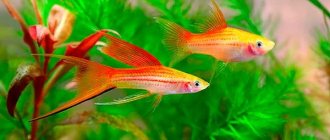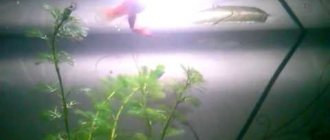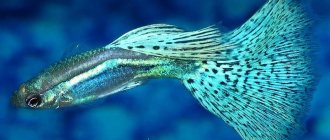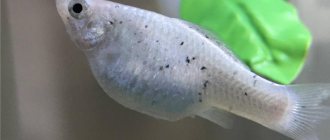Fish diseases
Swordtails
The ability to identify a disease by external signs is very important for every aquarist. It is very important to distinguish the cause of the disease. This will allow you to choose the right course of treatment. All diseases of swordtails that are caused by fungi are treated with fungicidal drugs, and bacterial diseases are treated with antiseptics.
Almost all swordtail diseases can be cured with salt baths. Fish tolerate this treatment well.
If you carefully monitor your pets, the disease can be detected at an early stage. Place the sick individual in a separate container in time, then there is a chance to preserve the health and life of the rest of the fish.
Healthy swordtails are bright, active and voracious.
Main signs of diseases:
- the fish becomes lethargic, moves little, freezes in place or lies on the bottom;
- the movement of a sick individual becomes chaotic and disorderly, it begins to rush about and rub against stones;
- bloating;
- White spots or shreds, similar to cotton wool, appear on the surface of the body.
In order to avoid infection of all pets, newly acquired swordtails are kept in quarantine for the first two weeks. If there are sick individuals among them, then the diseases should manifest themselves during this period.
Injuries
Injuries can be caused by altercations between males and fights between fish of different species. Therefore, it is important that there are a sufficient number of females in the aquarium. The optimal ratio is three girls for one boy. In addition, fish can be injured by sharp edges of equipment, decorations, and soil.
In order to avoid infection and the appearance of white plaque on the surface of the wound, hydrogen peroxide (5-10 ml per 20 l) or iodinol is injected into the water. You can also use streptocide.
Kinds
Today there are many varieties of swordtails. For example, aquarists distinguish them by the shape of their fins. There are these types:
Flag
There is no ray on the caudal fin, but the dorsal fin is high and wide;
Veiled
The tail has ragged edges with long rays, forming a veil;
Lyrebirds
In such fish, the upper and lower rays are equal in length;
Sailing
Similar to the flag species, but the fin is more luxurious and longer;
Forked
They are similar to lyrebirds, but have three arms that form a fork.
Today, thanks to the work of geneticists, many breeds of swordtails have been developed, which sometimes have completely unimaginable color and shape:
Alvarez
This is a wild breed, this is how the fish look in their natural environment. They have a gray-greenish transparent color, and along the body there are two red longitudinal stripes, between which a blue-blue stripe is visible. As a rule, the size of alvarez does not exceed 5 cm;
Clementia
They grow up to 5 cm, have a bluish color with a bright red stripe along the body. The color of the sword is lemon, with black edging. Found in Mexican waters, and rarely in aquariums as they are extremely difficult to breed;
Montezuma
Rare representatives of the species. They have a rich yellow color with black and silver splashes. The process is black, with a bluish-silver tint;
Pygmies
Females are distinguished by a grayish-transparent body shade, and males have a lemon color. Along the body there is a brown stripe, characteristic of wild breeds;
Roundhead
He has a tall body and a round forehead. The dorsal fin is wide and high, yellow with black specks. The body is gray with black vertical stripes. They are distinguished by very aggressive behavior;
Green
The first species to be crossed. It has a narrow body and a sharp tail fin that resembles a sword. There is a red stripe along the body, from the gills to the tail. The sword has a black edge. A rare species because it is valuable for breeders;
Red
The most common of artificially grown breeds. It arose from crossing a green (ordinary) swordtail with red platies. It is distinguished by its bright, rich color and long sword;
Black
Appeared by crossing the common swordtail and black platies. They have a black body and a lime green tail and fins;
Citric
Almost identical to green swordtails in body and fin shape. They differ only in their lemon color. Difficult to breed;
Bulgarian white
Albino fish, unpretentious in care and maintenance, are very hardy. They are red in color with white spots that can grow over the body and change size and shape;
Calico
They have a three-color coloration - a white and red body with black spots. Very difficult to breed;
Cuban
It is also called red-black. It has a bright red color and a black spot that stretches along the entire body;
Rainbow
They are hybrid forms of white Bulgarian swordtails. They have a golden-green tint and red stripes along the body. The tail and fins are also rich red;
Pineapple
It has a yellow color, with red splashes. The fins and upper back are also colored red. The color of the sword varies from lemon to orange;
brindle
It has a round body shape and ruby colored scales. Black spots are scattered throughout the body, the tail is also black. However, the fins have a red tint;
Koi Kohaku
This species does not have a sword, and the fins are transparent, with a bluish tint. The head and tail of the fish are bright carrot-colored, and the middle of the body is white or cream;
Mountain
The body is creamy yellow and has mottling on the body and fins. The scales and sword are lilac in color and have a black edge;
Microsword
The body shape is similar to platies. They have a gray-olive color with a blue tint with transverse blue stripes on the abdomen. The tail and fins are transparent yellow with black speckles. They have a sword-like process, no more than 0.5 cm long;
Chlorine poisoning
Swordtails are very active and consume more oxygen than many other fish species. They have to breathe frequently and pass more water through their gills. As a result, these fish are very often poisoned by the chlorine contained in the water.
Signs of poisoning:
- mucus on gills;
- changes in behavior (swordtails become twitchy and lethargic);
- the gills become unnaturally yellow;
- fish jump out of the aquarium.
Methods of prevention and treatment:
- Before pouring water into the aquarium, you need to let it sit for two days or use a water conditioner and stir the water well.
- Buy a chlorometer and check the amount of chlorine in the water. The norm is 0.03-0.05 milligrams per 1 liter.
- After the first signs of poisoning appear, transplant the swordtails into clean water.
Feeding
There is no need to purchase special feed. Fish can eat “from the common table”, along with all other inhabitants of the reservoir. A varied diet will allow them to develop, grow active and healthy.
When feeding swordtails, there are several options to consider:
- Specialized dry food, frozen bloodworms or daphnia.
- Self-prepared food from plant ingredients - seaweed or spinach, as well as nettle or lettuce leaves scalded with boiling water to soften.
- Additional feeding in the form of boiled egg yolks or crushed crackers.
It is also better to maintain a regular feeding regime, since the swordtail is a voracious fish. A few days of diet will be useful and will help avoid the occurrence of the disease against this background. After abstinence, it is better to start feeding slowly so as not to provoke overeating.
In the absence of a filter, you need to remove the remaining food yourself, otherwise the water will quickly deteriorate, and for swordtails, as for other species of poeciliids.
Lack of oxygen
Swordtails swim near the surface and gasp for air. If there is a lot of carbon dioxide in the aquarium, then the snails also begin to float to the surface. As a result, swordtails begin to choke, stop reproducing, and refuse to eat. In order to correct the situation, aeration equipment is installed in the aquarium, and the population of the aquarium is reviewed.
Sex differences
It is extremely easy to distinguish males from females in swordtails. Only the male has a sword on the caudal fin, the long outgrowth from which the fish got its name. Also, in all viviparous animals, the anal fin of the male is pointed and narrow (gonopodium), and the anal fin of the female is wide.
Quite often it happens that a female swordtail suddenly grows a sword and becomes a male! At the same time, she behaves like a male, cares for other females, but is infertile. The reasons for this phenomenon are not completely clear.
Female with upper tail
Ichthyophthiriasis (semolina)
The cause of the disease, as a rule, is improper living conditions, especially sudden changes or low temperature. The swordtail itches on stones, soil and all protruding objects. A rash resembling semolina appears on the body. If the fish begins to lower its fins, this is also one of the symptoms of the disease.
Semolina is a self-explanatory popular name for ichthyophthyriosis.
The cause of the disease is ciliates equiciliata. It is often found in aquariums, but only individuals with low immunity become ill. There is no effective treatment for this disease. The only way to improve the situation is to gradually raise the water temperature to +26 and protect the swordtails from stress. The fish's body must cope with the disease on its own.
How can you tell if your fish is sick?
All diseases occur either due to poor living conditions or due to various infections and parasites entering the aquarium.
It is important to understand that poor quality care significantly weakens the fish’s immunity, so the risk of becoming infected with fungi or viruses becomes much higher.
Most often, even a cursory glance is enough to identify a sick individual:
- the fish stops swimming, lies on the bottom or becomes inactive;
- sometimes sick Swordtails, on the contrary, move chaotically throughout the aquarium, trying to rub against the walls or ground;
- the individual loses its appetite, its tummy swells;
- white dots, spots, cloudy coating, fluffy tufts appear on the body;
- fins break off or become thinner.
If such signs are observed in only one fish, then it is better to place it in a quarantine container.
Quarantine is a fairly long-term keeping of fish in a separate, specially equipped quarantine aquarium (quarantine tank).
Chilodenellosis
The cause of this disease is a very small parasitic creature called Chilodonella.
Signs of the disease:
- reduced activity (the sick individual freezes in place and sways slightly);
- the fish's appetite decreases;
- the fin, which is located on the back, descends, and if you look closely, you can identify a gray-blue coating underneath it.
As a rule, swordtails suffer from chylodenosis more often than all other species. Even if different types of fish live in the aquarium, parasites often settle only on swordtails.
Obvious signs of chylodenalosis can be seen too late!
Chilodenelosis is eliminated with the help of antiprotozoal drugs. The success of treatment depends on the stage of the disease. The earlier treatment is started, the higher the chances of survival. All sick individuals must be quarantined.
Compatibility with other fish
The swordtail, being a peace-loving aquarium fish, gets along without problems with almost all small, non-hostile fish. The best neighbors of the Swordtail in the aquarium are its closest “relatives” from the Poeciliaceae family - almost all species of Plaeciliidae and Mollies, ray-finned fish Barbus and Danio, as well as Minors and Tetras of the Characin family.
Keeping Swordtails with almost all types of large Cichlids that have a particularly aggressive disposition is contraindicated. Also with most fish of the macropod family - Cockerels, Macropods, Laliuses, and other slow fish, which Swordtails, being very mobile, can damage their luxurious veil fins.
Mycobacteriosis
This disease is dangerous not only for swordtails, but also for other inhabitants of the aquarium. A sick fish stops actively eating food and loses activity. If the disease progresses, the swordtail is poorly oriented in space and loses the ability to swim normally. Sometimes abscesses, black spots or ulcers appear on the fish's body. The swordtail lies on the bottom and refuses to eat.
Mycobacteriosis in swordtails is deadly.
In the earliest stages, the problem can be solved with copper sulfate, trypoflavin or monocycline. In advanced stages, the fish die.
What to feed swordtails?
Swordtails are omnivores, like most aquarium fish. Dry, live and frozen food is suitable for feeding them. The majority of the diet should be food of plant origin (special flakes are mainly used), since in nature swordtails mainly feed on algae with thin leaves and stems. Live food can be anything - in this regard, swordtails are absolutely not demanding.
Fin rot
This bacterial infection is common in swordtails. It affects fry and adults with weakened immune systems. External signs of the disease include clouding and destruction of the fin. The disease is curable only if the damage has not spread to the fish’s body, otherwise the rot will primarily affect the nervous system.
If you notice the first signs of the disease in time, the treatment will be successful. It is enough to place all sick swordtails in a separate container and use a weak solution of methylene blue instead of water. The liquid should have a pale turquoise color.
Fin rot begins on one fin or tail and later spreads to all the others.
Treatment with salt has a good effect. Dissolve 1 tablespoon in 10 liters of water. This will not harm healthy swordtails, and the number of cases will decrease.
If these measures do not help, then it is worth using chloramphenicol. 1 crushed tablet per 20 liters of water is enough.
After signs of the disease have disappeared, swordtails must be quarantined for at least another 5 days.
Breeding swordtails
Swordtails are viviparous aquarium fish, that is, the female immediately gives birth to a completely viable fry.
Puberty of these fish occurs at 6-8 months of life. Sometimes 3-month-old individuals can breed. Before breeding, future breeders are fed nutritious food with a high protein content - with such a diet, the fry will be strong and healthy.
To speed up the reproduction process of swordtails, replace part of the water in the aquarium with settled fresh water of medium hardness, and raise the temperature to 26-28 degrees (the temperature regime is changed gradually). The aqueous medium must be neutral or slightly alkaline. The same parameters of the aquatic environment should be in the spawning aquarium, where the female is placed before giving birth.
In a female ready for reproduction, the abdomen takes on a rounded shape. During this period, the male's gonopodium noticeably increases. To produce healthy offspring, the female must be at least 8 months old.
Female swordtails are fertilized in utero. Some of the male reproductive cells remain inside the female’s body after fertilization and therefore the next time reproduction occurs without the participation of the male. Swordtails reproduce well - their fry can appear every 30 days. At a time, one female produces from 50 to 200 babies.
The number of fry strongly depends on the age of the female: young females have smaller offspring than mature individuals. The number of babies a female swordtail has is determined by the type of fish and the conditions of detention. From fertilization to the appearance of the fry, 4-6 weeks usually pass; during this period of time, the female’s abdomen is rounded and becomes almost square before giving birth.
Before the babies appear, it is better to place the female in a spawning area with comfortable living conditions. After giving birth, the mother fish is returned to the general aquarium, otherwise she will eat her fry. In an aquarium with fry, carefully change the water and monitor its temperature.
From the moment of birth, fry are fed the same food as adult fish. The live food is first crushed with a knife, and the dry particles are carefully rubbed between your fingers.
Swordtail fry are characterized by rapid growth. Already a month after birth, the young animals are transplanted into a common aquarium.
Dropsy
As a rule, dropsy occurs as a result of exposure to a viral or bacterial infection, poor nutrition, the presence of parasites, temperature changes, or high levels of nitrites or nitrates in the water. Swordtails become infected from contact with fellow tribesmen, soil or live food.
Dropsy spreads easily and quickly to all inhabitants of the aquarium.
External signs of the disease:
- apathy;
- swordtails lie on the bottom;
- breathe quickly;
- swollen abdomen;
- the scales are swollen and stick out in an unnatural way;
- often hang in one place.
To rid your pet of excess liquid, add Epsom salt to the water (1-2 tsp per 40 liters of water). The problem can also be eliminated with the help of the following drugs: potassium permanganate, maracin, chlorafeminicol, bicilin.
Infection often poses a danger to people, so protective gloves are worn when working with fish.
Team of Doctors
Internal varicose veins are very difficult to recognize in the initial stages. Therefore, everyone who has a genetic predisposition to this disease is recommended to undergo a preventive ultrasound at least once a year. Since the deep veins are surrounded on all sides by muscles, it is impossible to detect their deformation during visual inspection
Rare diseases
Fungal infection
Also known as “cotton wool disease,” it can manifest itself as a thin, cotton-like coating. It occurs as a result of hypothermia.
Columnaris
Also called bacterial mouth rot, it also causes a white coating, but it forms around the mouth.
The fish has a swollen eye
The causes of the disease are injury or bacterial infection. Also, incorrect conditions of detention can often lead to this result. Often, as a result of failure to comply with all conditions, nitrites, nitrates, and ammonia accumulate in the water. To eliminate the problem, it is enough to test the water, and if the readings exceed the norm (and usually they do), the liquid should be replaced and the nitrogen concentration should be monitored in the future.
An eye tumor can be both a disease and a symptom.
In what cases can it be treated in a community aquarium, and when is it better to remove a sick fish?
If the disease is caused by a bacterial or fungal infection, then the sick individual must be placed in a quarantine container so as not to infect other Swordtails and other inhabitants of the aquarium.
When health problems with pets arise due to non-compliance with the rules of keeping, the owner needs to treat the fish in a common aquarium. Beginner fish must get used to the water in which they will live in the future. In the future, quality care should be provided.
We also recommend reading interesting and informative articles about the maintenance of Swordtails, their types and compatibility with other fish.
Prevention
It is much easier to prevent a disease than to get rid of the consequences later. Preventive measures:
Salt treatment
Before releasing new fish from the store into a community aquarium, they should be placed in a saline solution for 20 minutes. To prepare the solution, dilute 10 grams of salt in 10 liters of water. After this procedure, new fish are placed in a separate aquarium for a temporary quarantine.
One teaspoon contains 7 grams of salt (without a slide).
Temporary quarantine
All newly acquired fish are placed in a separate aquarium for one to two decades. If during this time the fish do not show signs of illness, then they can be placed in the general aquarium.
Conditions of detention
An aquarium is a complex ecosystem that must be maintained by the owner.
Each type of fish needs certain temperature conditions, water composition, timely change of liquid, water purification by filtration and aeration. The optimal temperature for keeping swordtails is from +23 C to +25 C. Maintaining proper conditions is the best prevention.
High quality feed
Before purchasing, you should ask the seller for a quality certificate for the product. If in doubt, you should refuse the purchase.
Features of using live food
04:33
Sword bearers. CARE, MAINTENANCE, FEEDING AND REPRODUCTION
06:48
Sword bearer. Maintenance, feeding, breeding, reproduction. Part 1
If live larvae are used as food, they can also be a source of infection or contain parasitic larvae. To protect your pets, you should put bloodworms and tubifex in the freezer for several days. During this time, the parasite eggs, if they do not die, will be noticeably weakened and will not pose a great danger. Live food can also be disinfected with a solution of potassium permanganate or methylene blue.
Diet variety
Dried gammarus and daphnia are not enough for fish throughout their life. If it is not possible to give live bloodworms or tubifex, then boiled yolk or finely grated beef heart will do.
Plant preparation
All new plants are also treated with a weak solution of potassium permanganate.
To successfully breed swordtails, it is necessary to provide the correct temperature conditions, clean water with a high oxygen content, and a varied diet. These are active fish that defend their territory and females. The number of individuals should be controlled and conflicts between them should be avoided.
The Red Swordtail wishes health to your pets!
Maintenance and care
Swordtails are fish that are loved by aquarium owners for their ease of care. The homeland of the fish is South America and therefore an aquarium with swordtails must meet several simple requirements:
- the water temperature should be maintained at 20–26 °C, with a maximum and short-term decrease of perhaps up to 15 °C;
- the acidity of the water should be at a level of 7–8 pH, which can be easily determined using special test strips;
- control of water hardness, which can range from 8 to 25 DH;
- provide aeration and water purification;
- carry out a standard water change of 1/3 of the total volume.
Aquarium swordtail fish can live in both salt and fresh water, so aquarium water can be salty in order to get along with other inhabitants. Caring for swordtails does not require effort; the main thing here is not to overdo it and remember that these fish do not like light, they are accustomed to living among dense thickets.










